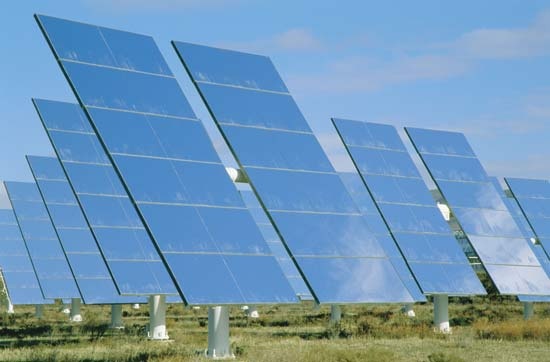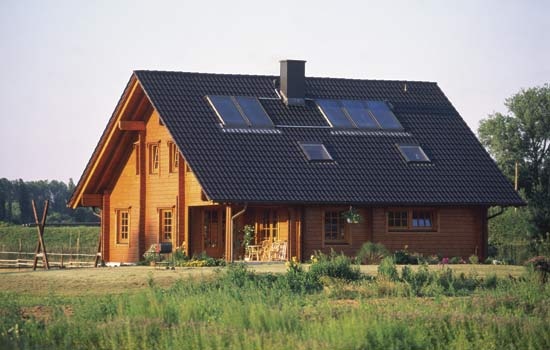solar energy
 radiation from the Sun capable of producing heat, causing chemical reactions (chemical reaction), or generating electricity. The Sun is an extremely powerful energy source, and sunlight is by far the largest source of energy received by the Earth, but its intensity at the Earth's surface is actually quite low. This is essentially because of the enormous radial spreading of radiation from the distant Sun. A relatively minor additional loss is due to the Earth's atmosphere and clouds, which absorb or scatter as much as 54 percent of the incoming sunlight. Yet the total amount of solar energy incident on Earth is vastly in excess of the world's current and anticipated energy requirements. If suitably harnessed, this highly diffused source has the potential to satisfy all future energy needs. In the 21st century solar energy is expected to become increasingly attractive as an energy source because of its inexhaustible supply and its nonpolluting character, in stark contrast to the finite fossil fuels (fossil fuel) coal, petroleum, and natural gas.
radiation from the Sun capable of producing heat, causing chemical reactions (chemical reaction), or generating electricity. The Sun is an extremely powerful energy source, and sunlight is by far the largest source of energy received by the Earth, but its intensity at the Earth's surface is actually quite low. This is essentially because of the enormous radial spreading of radiation from the distant Sun. A relatively minor additional loss is due to the Earth's atmosphere and clouds, which absorb or scatter as much as 54 percent of the incoming sunlight. Yet the total amount of solar energy incident on Earth is vastly in excess of the world's current and anticipated energy requirements. If suitably harnessed, this highly diffused source has the potential to satisfy all future energy needs. In the 21st century solar energy is expected to become increasingly attractive as an energy source because of its inexhaustible supply and its nonpolluting character, in stark contrast to the finite fossil fuels (fossil fuel) coal, petroleum, and natural gas. The sunlight that reaches the ground consists of nearly 50 percent visible light, 45 percent infrared radiation, and smaller amounts of ultraviolet (ultraviolet radiation) and other forms of electromagnetic radiation. This radiation can be converted either into thermal energy (heat) or into electrical energy, though the former is easier to accomplish. Two main types of devices are used to capture solar energy and convert it to thermal energy: flat-plate collectors and concentrating collectors. Because the intensity of solar radiation at the Earth's surface is so low, both types of collectors must be large in area. Even in sunny parts of the world's temperate regions, for instance, a collector must have a surface area of about 40 square metres (430 square feet) to gather enough energy to serve the energy needs of one person.
The sunlight that reaches the ground consists of nearly 50 percent visible light, 45 percent infrared radiation, and smaller amounts of ultraviolet (ultraviolet radiation) and other forms of electromagnetic radiation. This radiation can be converted either into thermal energy (heat) or into electrical energy, though the former is easier to accomplish. Two main types of devices are used to capture solar energy and convert it to thermal energy: flat-plate collectors and concentrating collectors. Because the intensity of solar radiation at the Earth's surface is so low, both types of collectors must be large in area. Even in sunny parts of the world's temperate regions, for instance, a collector must have a surface area of about 40 square metres (430 square feet) to gather enough energy to serve the energy needs of one person.The most widely used flat-plate collectors consist of a blackened metal plate, covered with one or two sheets of glass, that is heated by the sunlight falling on it. This heat is then transferred to air or water, called carrier fluids, that flow past the back of the plate. The heat may be used directly, or it may be transferred to another medium for storage. Flat-plate collectors are commonly used for hot-water heating and house heating. The storage of heat for use at night or on cloudy days is commonly accomplished by using insulated tanks to store the water heated during sunny periods. Such a system can supply a home with hot water drawn from the storage tank, or, with the warmed water flowing through tubes in floors and ceilings, it can provide space heating. Flat-plate collectors typically heat carrier fluids to temperatures ranging from 66 to 93 °C (150 to 200 °F). The efficiency of such collectors (i.e., the proportion of the energy received that they convert into usable energy) ranges from 20 to 80 percent, depending on the design of the collector. (See also solar heating.)
When higher temperatures are needed, a concentrating, or focusing, collector is used. These devices concentrate sunlight received from a wide area onto a small blackened receiver, thereby considerably increasing the light's intensity in order to produce high temperatures. The arrays of carefully aligned mirrors or lenses used in these so-called solar furnaces can focus enough sunlight to heat a target to temperatures of 2,000 °C (3,600 °F) or more. This heat can be used to study the properties of materials at high temperatures, or it can be used to operate a boiler, which in turn generates steam for a steam-turbine–electric-generator power plant. The solar furnace has become an important tool in high-temperature research. For producing steam, the movable mirrors are so arranged as to concentrate large amounts of solar radiation upon blackened pipes through which water is circulated and thereby heated.
Solar radiation may be converted directly into electricity by solar cells (solar cell) (photovoltaic cells (photovoltaic effect)). In such cells, a small electric voltage is generated when light strikes the junction between a metal and a semiconductor (such as silicon) or the junction between two different semiconductors. (See photovoltaic effect.) The power generated by a single photovoltaic cell is typically only about two watts. By connecting large numbers of individual cells together, however, as in solar-panel arrays, hundreds or even thousands of kilowatts of electric power can be generated in a solar electric plant. The energy efficiency of most present-day photovoltaic cells is only about 15 to 20 percent, and since the intensity of solar radiation is low to begin with, huge and costly assemblies of such cells are required to produce even moderate amounts of power. Consequently, photovoltaic cells that operate on sunlight or artificial light have so far found major use only in low-power applications—as power sources for calculators and watches, for example. Larger units have been used to provide power for water pumps and communications systems in remote areas and for weather and communications satellites.
 Solar energy is also used on a small scale for purposes other than those described above. In some countries, for instance, specially designed solar ovens are employed for cooking, and solar energy is used to produce salt from seawater by evaporation.
Solar energy is also used on a small scale for purposes other than those described above. In some countries, for instance, specially designed solar ovens are employed for cooking, and solar energy is used to produce salt from seawater by evaporation.The potential for solar energy is enormous, since about 200,000 times the world's total daily electric-generating capacity is received by the Earth every day in the form of solar energy. Unfortunately, though solar energy itself is free, the high cost of its collection, conversion, and storage still limits its exploitation.
- Dinwiddie, Robert
- Dinís Dias
- Dio Cassius
- diocese
- Diocles
- Diocletian
- Diocletian, Palace of
- Diocletian window
- Diodati, Giovanni
- diode
- Diodorus Cronus
- Diodorus Siculus
- Diodotus I
- Diodotus II
- Diogenes
- Diogenes Laërtius
- Diogenes Of Apollonia
- Diogenes Of Babylon
- Diognetus, Letter to
- Diogo Cão
- Diogo Gomes
- Diomede Islands
- Diomedes
- Dion
- Dion and the Belmonts